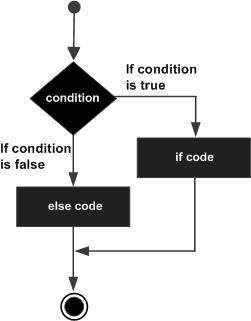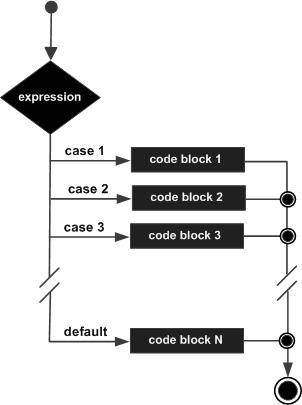1. Assume given marks are x for a student 2. If given marks are more than 95 then 3. Student is brilliant 4. If given marks are less than 30 then 5. Student is poor 6. If given marks are less than 95 and more than 30 then 7. Student is averageNow, question is how to write programming code to handle such situation. Almost all the programming languages provide conditional i.e., decision making statements which work based on the following flow diagram:
 Let's write a C program with the help of if conditional statements to convert above given situation into programming code:
Let's write a C program with the help of if conditional statements to convert above given situation into programming code:#include <stdio.h> main() { int x = 45; if( x > 95) { printf( "Student is brilliant\n"); } if( x < 30) { printf( "Student is poor\n"); } if( x < 95 && x > 30 ) { printf( "Student is average\n"); } }When above program is executed, it produces the following result:
Student is averageAbove program makes use of if conditional statements. Here, first if statement checks whether given condition i.e., variable x is greater than 95 or not and if it finds condition is true, then the conditional body is entered to execute given statements. Here we have only one printf() statement to print a remark about the student.
Similar way, second if statement works. Finally, third if statement is executed, here we have following two conditions:
- First condition is x > 95
- Second condition is x < 30
This tutorial will give you basic idea on various forms of if statements and an introduction of switch statements available in C programming language. Different programming languages provide different type of decision making statements but basic concept will remain same as explained in this tutorial.
if...else statement
An if statement can be followed by an optional else statement, which executes when the boolean expression is false. The syntax of an if...else statement in C programming language is:if(boolean_expression) { /* Statement(s) will execute if the boolean expression is true */ } else { /* Statement(s) will execute if the boolean expression is false */ }Above syntax can be represented in the form of a flow diagram as shown below:
 An if...else statement is useful when we have to take a
decision out of two options. For example, if student secures more marks
than 95, then student is brilliant otherwise no, such situation can be
coded as follows:
An if...else statement is useful when we have to take a
decision out of two options. For example, if student secures more marks
than 95, then student is brilliant otherwise no, such situation can be
coded as follows:#include <stdio.h> main() { int x = 45; if( x > 95) { printf( "Student is brilliant\n"); } else { printf( "Student is not brilliant\n"); } }When above program is executed, it produces the following result:
Student is not brilliant
if...elseif...else statement
An if statement can be followed by an optional else if...else statement, which is very useful to test various conditions using single if...else if statement.When using if , else if , else statements, there are few points to keep in mind:
- An if can have zero or one else's and it must come after any else if's.
- An if can have zero to many else if's and they must come before the else.
- Once an else if succeeds, none of the remaining else if's or else's will be tested.
if(boolean_expression 1) { /* Executes when the boolean expression 1 is true */ } else if( boolean_expression 2) { /* Executes when the boolean expression 2 is true */ } else if( boolean_expression 3) { /* Executes when the boolean expression 3 is true */ } else { /* Executes when the none of the above condition is true */ }Now with the help of if...elseif...else statement, very first program can be coded as follows:
#include <stdio.h> main() { int x = 45; if( x > 95) { printf( "Student is brilliant\n"); } else if( x < 30) { printf( "Student is poor\n"); } else if( x < 95 && x > 30 ) { printf( "Student is average\n"); } }When above program is executed, it produces the following result:
Student is average
The switch statement
A switch statement is an alternative of if statements which allows a variable to be tested for equality against a list of values. Each value is called a case, and the variable being switched on is checked for each switch case. This has following syntax:switch(expression){ case ONE : statement(s); break; case TWO: statement(s); break; ...... default : statement(s); }The expression used in a switch statement must give an integer value, which will be compared for equality with different cases given. Wherever, expression value matches with case value, the body of that case will be executed and finally switch will be terminated using break statement. If break statement is not provided, then computer continues executing other statements available below to the matched case. If none of the cases matches, then default case body is executed.
Above syntax can be represented in the form of a flow diagram as shown below:
 Now, let's consider another example where we want to write equivalent
English word for the given number. Then, it can be coded as follows:
Now, let's consider another example where we want to write equivalent
English word for the given number. Then, it can be coded as follows:#include <stdio.h> main() { int x = 2; switch( x ){ case 1 : printf( "One\n"); break; case 2 : printf( "Two\n"); break; case 3 : printf( "Three\n"); break; case 4 : printf( "Four\n"); break; default : printf( "None of the above...\n"); } }When above program is executed, it produces the following result:
Two
Decisions in Java
Following is the equivalent program written in Java programming language. Java programming language also provides if, if...else, if...elseif...else and switch statements.You can try to execute the following program to see the output, which must be identical to the result generated by the above C example.
public class DemoJava { public static void main(String []args) { int x = 45; if( x > 95) { System.out.println( "Student is brilliant"); } else if( x < 30) { System.out.println( "Student is poor"); } else if( x < 95 && x > 30 ) { System.out.println( "Student is average"); } } }
Decisions in Python
Following is the equivalent program written in Python. Python provides if, if...else, if...elif...else and switch statements. Here, you must note that Python programming does not make use of curly braces for conditional body, instead it simply identifies the body of the block using indentation of the statements.You can try to execute following program to see the output:
x = 45 if x > 95: print "Student is brilliant" elif x < 30: print "Student is poor" elif x < 95 and x > 30: print "Student is average" print "The end"When above program is executed, it produces the following result:
Student is average The end
No comments:
Post a Comment